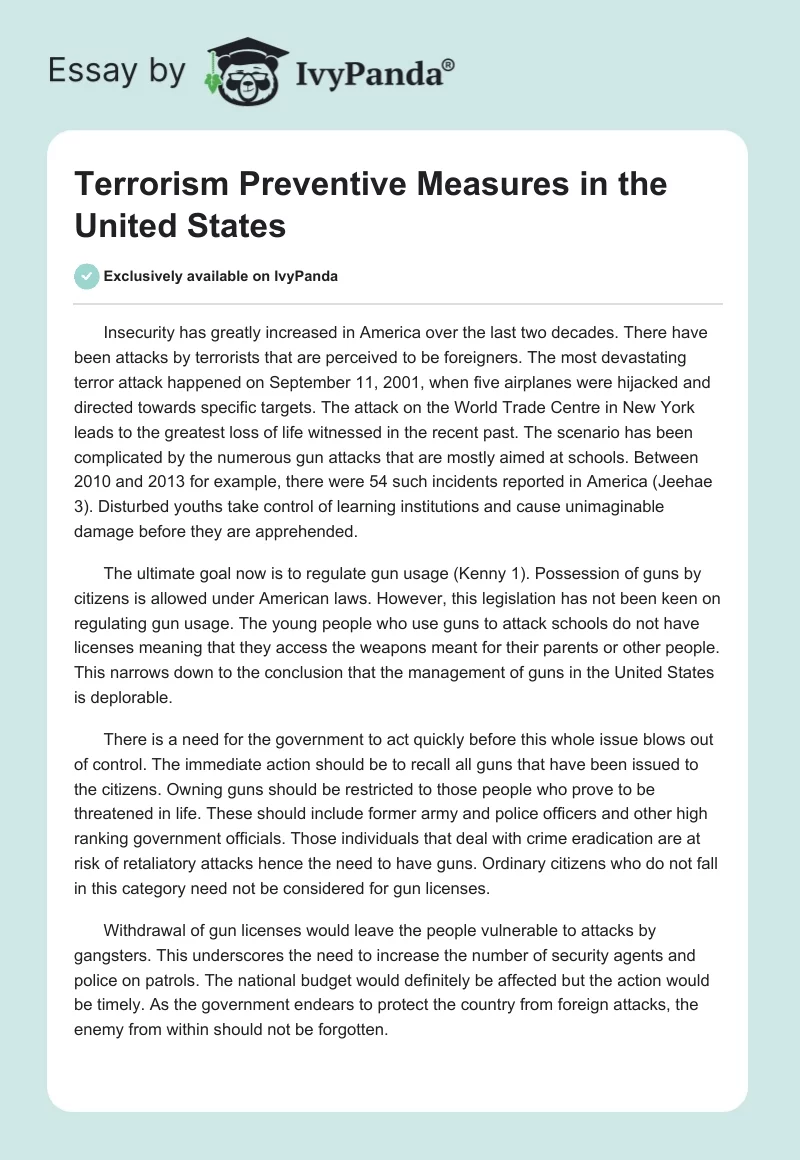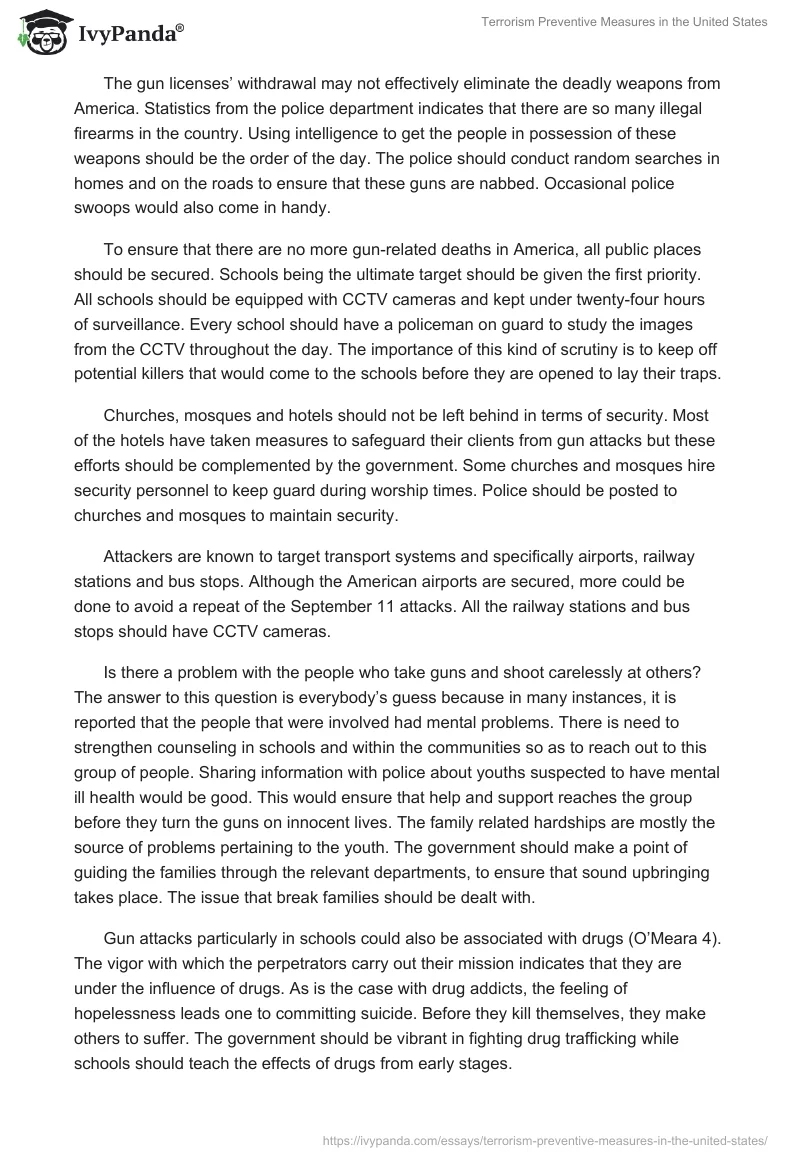Insecurity has greatly increased in America over the last two decades. There have been attacks by terrorists that are perceived to be foreigners. The most devastating terror attack happened on September 11, 2001, when five airplanes were hijacked and directed towards specific targets. The attack on the World Trade Centre in New York leads to the greatest loss of life witnessed in the recent past. The scenario has been complicated by the numerous gun attacks that are mostly aimed at schools. Between 2010 and 2013 for example, there were 54 such incidents reported in America (Jeehae 3). Disturbed youths take control of learning institutions and cause unimaginable damage before they are apprehended.
The ultimate goal now is to regulate gun usage (Kenny 1). Possession of guns by citizens is allowed under American laws. However, this legislation has not been keen on regulating gun usage. The young people who use guns to attack schools do not have licenses meaning that they access the weapons meant for their parents or other people. This narrows down to the conclusion that the management of guns in the United States is deplorable.
There is a need for the government to act quickly before this whole issue blows out of control. The immediate action should be to recall all guns that have been issued to the citizens. Owning guns should be restricted to those people who prove to be threatened in life. These should include former army and police officers and other high ranking government officials. Those individuals that deal with crime eradication are at risk of retaliatory attacks hence the need to have guns. Ordinary citizens who do not fall in this category need not be considered for gun licenses.
Withdrawal of gun licenses would leave the people vulnerable to attacks by gangsters. This underscores the need to increase the number of security agents and police on patrols. The national budget would definitely be affected but the action would be timely. As the government endears to protect the country from foreign attacks, the enemy from within should not be forgotten.
The gun licenses’ withdrawal may not effectively eliminate the deadly weapons from America. Statistics from the police department indicates that there are so many illegal firearms in the country. Using intelligence to get the people in possession of these weapons should be the order of the day. The police should conduct random searches in homes and on the roads to ensure that these guns are nabbed. Occasional police swoops would also come in handy.
To ensure that there are no more gun-related deaths in America, all public places should be secured. Schools being the ultimate target should be given the first priority. All schools should be equipped with CCTV cameras and kept under twenty-four hours of surveillance. Every school should have a policeman on guard to study the images from the CCTV throughout the day. The importance of this kind of scrutiny is to keep off potential killers that would come to the schools before they are opened to lay their traps.
Churches, mosques and hotels should not be left behind in terms of security. Most of the hotels have taken measures to safeguard their clients from gun attacks but these efforts should be complemented by the government. Some churches and mosques hire security personnel to keep guard during worship times. Police should be posted to churches and mosques to maintain security.
Attackers are known to target transport systems and specifically airports, railway stations and bus stops. Although the American airports are secured, more could be done to avoid a repeat of the September 11 attacks. All the railway stations and bus stops should have CCTV cameras.
Is there a problem with the people who take guns and shoot carelessly at others? The answer to this question is everybody’s guess because in many instances, it is reported that the people that were involved had mental problems. There is need to strengthen counseling in schools and within the communities so as to reach out to this group of people. Sharing information with police about youths suspected to have mental ill health would be good. This would ensure that help and support reaches the group before they turn the guns on innocent lives. The family related hardships are mostly the source of problems pertaining to the youth. The government should make a point of guiding the families through the relevant departments, to ensure that sound upbringing takes place. The issue that break families should be dealt with.
Gun attacks particularly in schools could also be associated with drugs (O’Meara 4). The vigor with which the perpetrators carry out their mission indicates that they are under the influence of drugs. As is the case with drug addicts, the feeling of hopelessness leads one to committing suicide. Before they kill themselves, they make others to suffer. The government should be vibrant in fighting drug trafficking while schools should teach the effects of drugs from early stages.
The schools should also train the children in life saving skills. This will go a long way in helping them to know how to conduct themselves in case there was a gun attack in their schools. The same should also be extended to homes and other public places. The courts should mete out stiffer penalties for offenders who are found guilty of being in possession of illegal firearms. This would discourage other people who might have the intentions of using guns. All in all, these measures will ensure that America becomes a safe place.
Works Cited
JeeHae Helen, Lee. “School Shootings in the U.S. Public Schools: Analysis Through the Eyes of an Educator.” Review of Higher Education & Self-Learning 6.22 (2013): 88. Publisher Provided Full Text Searching File. Web.
Kenny, Jack. “Gun control or killer control? After shooting incidents in which multiple victims are killed, calls arise for gun control. But evidence tells us that guns control wanton killers, and without guns, deaths rise.” The New American 2012: 35. Opposing Viewpoints in Context. Web.
O’Meara, Kelly Patricia. Antidepressant Drugs Contributed to the Columbine School
Shooting. n.p.: Gale, Cengage Learning, 2012.Gale Virtual Reference Library. Web.


